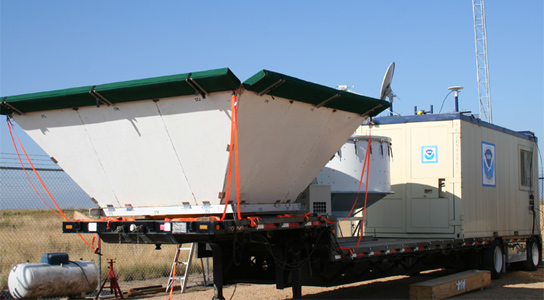
Mobile AR Observatory. Credit: NOAA
Atmospheric rivers are long, narrow conveyor belts of rainstorms that stream in from the Pacific Ocean. Meteorologists have been able to predict the storms five days in advance, thanks to a new network of weather sensors recently installed in California.
The network is only partially complete, and will be finished in 2014. It should allow the forecast of upcoming storms and floods with much greater precision, and provide a model warning system for flooding.
Atmospheric rivers flow at about 1.5 kilometers (about 1 mile) above the ocean surface, and extend thousands of miles out to sea, carrying as much water as 15 Mississippi Rivers. It strikes a coast as a series of storms, which arrive for days or weeks on end. Each storm dumps centimeters of rain or meters of snow. Meteorologists had difficulty predicting the amount of precipitation, and therefore possible flooding. Satellite radars that track airborne water vapor over the ocean do well there, but have trouble tracking it over land.
The NOAA, speaking at the American Geophysical Union conference last December, stated that satellites do not give a good assessment of winds within the corridor of water vapor, which affects how quickly they move rain inland.
The amount of flooding is strongly influenced by how wet or dry a region’s soil is before or during the storms, which can only be measured by sensors embedded directly in the ground. Rain causes more immediate flooding whereas snow may cause delayed flooding.
Snow radars are being deployed in 10 major watersheds. Soil moisture sensors are being installed at 43 sites across California, which will allow the prediction if an incoming storm will produce heavy runoff. Some of the snow radars and three-quarters of the soil sensors are already in place.
The four unique atmospheric river observatories, located about 400 km from one another, are about the size of a dump truck, look upward and show precise wind speed and direction at several altitudes, the total amount of water vapor above the site, and the elevation at which precipitation is rain or snow.
On November 23, the system proved its worth, allowing forecasters to predict five days in advance that an atmospheric river would begin plummeting the state. Storms started hitting the coast on November 28 and lasted 5 days, dumping up to 38 cm (15 in) of rain, causing flooding and mudslides. Forecasters used the information to warn residents about which rivers might flood, and when. California’s Department of Water Resources used the data to decide whether to mitigate flooding by opening or closing dams and other structures along the state’s rivers.









Be the first to comment on "Atmospheric River Observatories Allow Accurate Weather Prediction of Floods"